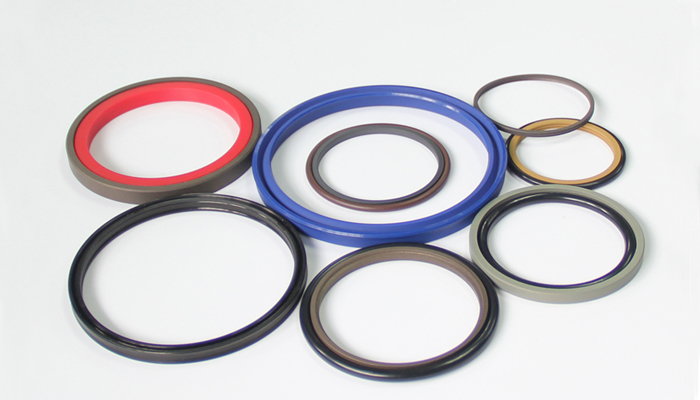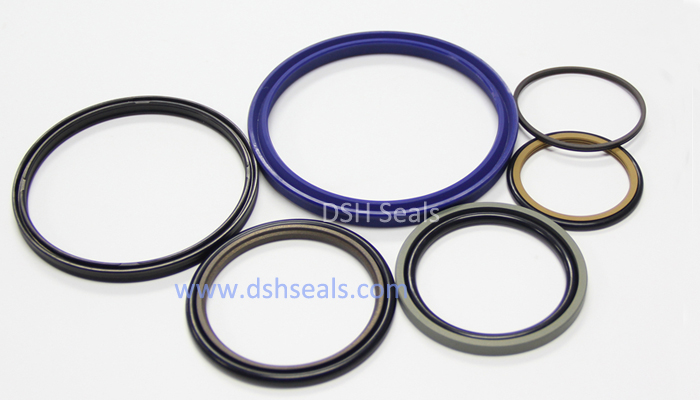Product Series
News
Design and selection of hydraulic seals
Update:2018-10-24
About hydraulic cylinder
The hydraulic cylinder is an important element for the final operation in the hydraulic system. The hydraulic cylinder is composed of cylinder, piston, piston rod, cylinder head, seal, etc. The function of the seal in the cylinder is to prevent leakage of the working medium and intrusion of outside dust and foreign matter.
External leakage will cause waste of working medium, pollute the machine and the environment, and even cause mechanical operation failure and equipment personal accidents; Internal leakage will cause the hydraulic system volumetric efficiency to drop sharply, fail to reach the required working pressure, or even work normally;
The dust particles that intrude into the system will cause and aggravate the wear and tear of hydraulic components, which will further lead to leakage. Modern hydraulic systems have extremely high requirements for seals, and their operational reliability and service life are an important indicator for measuring the quality of hydraulic systems.
Classification of hydraulic seals
The portion to be sealed is between the two mechanical coupling faces that require sealing. Generally, according to whether the coupling surface has relative motion during the operation of the machine, the hydraulic seal can be divided into two categories: dynamic seal and static seal.
According to the manufacturing materials, installation methods, structural forms, etc. of the seals, they are further divided into different sub-categories: non-metallic seals in static seals (O-rings, rubber gaskets, PTFE guide tapes, etc.), semi-metal seals (combined gaskets) , metal static seal (metal gasket), hydraulic static seal (sealant seal); self-sealing compression seal (O-ring, slide ring compact seal, special-shaped seal, etc.) in the dynamic seal, self-sealing self-tightening seal (U-ring, combined U-ring, Vee packing, composite lip seal, two-way combined lip seal, etc.), piston ring, mechanical seal, oil seal (rotary frame oil seal, high pressure oil seal, etc.) , dust seal (dust ring, skeleton dust ring).
About the principle of sealing
In addition to the gap seal, a seal is used to control the gap between adjacent two coupling surfaces below the minimum gap through which the liquid requiring sealing can pass. This minimum gap is determined by the pressure of the liquid, the surface tension (viscosity), and the molecular weight.
Self-sealing compression seal, the function of which is the contact pressure between the seal and the coupling member obtained by the pressing force (pre-compression force and medium working pressure) (it automatically increases with the working pressure of the medium), The sealing ring is run-fit on the sealing surface to block the leakage path to achieve the purpose of sealing; the self-sealing self-tightening sealing (lip sealing) is to use the reaction force generated by the deformation of the sealing ring to perform initial sealing at the medium pressure.
Under the action, the sealing lip is opened to make it close to the coupling surface, and the contact pressure is also increased with the increase of the working pressure of the medium to achieve the sealing effect.
About the principle of selection
1. Basic requirements
A, Under working pressure, it should have good sealing performance, and it can automatically improve its sealing performance with the increase of pressure, that is, there is no obvious increase in leakage under high pressure; B. Hydraulic seals work in fluid medium for a long time, must keep the material stable characteristics; C, Movement, static friction resistance of the seal is small, the friction coefficient should be stable, the movement parts can not be stuck or the movement is uneven; D, Small wear, long service life; E, Simple manufacturing, Easy to disassemble and install, low price.
2. Factors affecting sealing performance
A, The type of working medium; B, The use of oil temperature (based on the temperature of the sealing part); C, The size and waveform of the using pressure; D, The slip speed of the sealed coupling surface; E, The size of the extrusion gap; F , The degree of eccentricity of the seal and the coupling surface; G, The roughness of the seal coupling surface, the form, structure, size, position, etc. of the seal and the installation.
3. Design selection principle
The selection method of hydraulic seals must first be based on the conditions and requirements of the sealing equipment, such as load conditions, working pressure and speed, and changes, the use environment and specific requirements for sealing performance, correctly choose the sealing structure that matches it;
Then according to the type of using working medium and using temperature, the sealing material is reasonably selected; In addition, when using the sealing device in an environment with dust and impurities, it is necessary to select appropriate dust rings according to the pollution situation and the requirements for dust proof.
4. Design selection criteria
In the selection and design of hydraulic seals, international standards ISO, Chinese national standard GB, German industrial standard DIN and Japanese industrial standard JIS should be used.
About sealing materials
1. Requirements for the use of sealing materials
A, good stability in the working medium, that is, small volume change (not easy to expand and shrink), difficult to dissolve, soften and harden; B, large recovery in the working medium, permanent deformation; C, appropriate mechanical strength and hardness, after being affected by the working medium, the change is small; D, good heat resistance, cold resistance and vibration absorption performance; E, good wear resistance, small friction coefficient; F, material is dense; G, has softness and elasticity to fit the sealing surface; H, good ozone resistance and aging resistance, durable; I, easy to manufacture and process, cheap price.
2. Types and performance of commonly used seals
In the hydraulic system, the commonly used sealing materials are mainly synthetic rubber and synthetic resin. Among them, synthetic rubber is the main sealing material, which has the excellent elasticity and mechanical strength necessary for sealing materials, and has good oil resistance and heat resistance.
Therefore, its application range is very wide. Under conditions beyond the temperature specified by the rubber material and chemical abrasion resistance, when synthetic rubber cannot be used, synthetic resin materials such as polytetrafluoroethylene may be used; At high temperature and high pressure, synthesis rubber and synthetic resin materials are not available, metal materials are used.
When we work on site, the requirements for seals are higher than those for one assembly (new machine assembly). In the secondary assembly (maintenance replacement), the accuracy of the machine and the cleanliness of the oil are not as good as before. The using environment of the seals are getting worse and worse, and the working strength of the replacement seals, therefore, when using and assembling seals, it should be highly valued!
Attention should be paid to the selection and installation:
1. Select the reference equipment according to the working conditions of the equipment.
2. Try to use genuine
3. Improve their assembly style (such as installing a drain conduit at the position of the rod seal) when conditions permit (some machines have design problems at the beginning)
4. Strict requirements for regular assembly steps to reduce leakage caused by poor assembly.
Cylinder design, processing, installation precautions
1. Processing accuracy of the cylinder
Experiments have shown that the surface roughness Ra exceeds 0.8 um on the moving working surface in contact with the oil seal. The leakage and wear values of the oil seal will rise linearly,
so it is recommended that the working surface roughness is Ra0.1-0.8um. In order to ensure the sealing performance of the PU and avoid damage to the seal during the assembly process, the following aspects should be considered in the design and installation of the hydraulic cylinder:
2.Cylinder
Material: Generally used aluminum alloy, bronze, stainless steel, etc in carbon steel, low pressure system and good friction conditions.
Inner surface quality and roughness: The inner surface is generally required to be honed, polished or rolled. It is required to achieve a roughness of Ra 0.1-0.8 um and no vertical and horizontal knives.
3. Piston rod
Material: generally carbon steel, chrome-plated steel, low-pressure system and good friction conditions can be used in aluminum alloy, bronze, stainless steel and so on.
Surface quality and roughness: required roughness Ra0.2-0.4um, hard chrome plated after heat treatment
The piston rod of the hydraulic cylinder for construction machinery may be scratched by sand and gravel, and the surface hardness is required to be above HRC60.
4. Oil seal installation groove
Structural form: can be divided into integral groove and split groove
Rubber hydraulic seal
Rubber materials are one of the most commonly used materials for hydraulic seals. It has excellent resistance to mineral oil and water resistance. Different hardness and different shapes can be made according to requirements. The rubber material can be vulcanized, injection molded, and machined. Add fiber and cotton to expand its range of use.
Rubber seals mainly have U-rings, L-rings and V-rings. Due to the increasing use pressure of hydraulic pressure, the required sealing reliability and service life are increasing. In order to meet these requirements, rubber seals have made great improvements in the manufacturing process, materials, sealing lip design and sealing structure in the past two decades.


